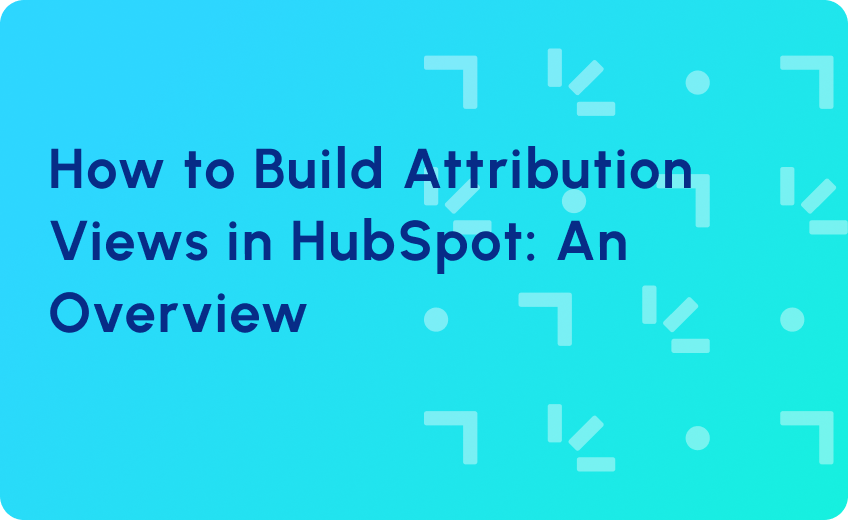
HubSpot for RevOps: Build a Full-Funnel Revenue Engine
If your HubSpot instance is only serving marketing, you’re not getting the ROI you should be. HubSpot was built for more than landing pages and email campaigns. When configured strategically, it becomes the backbone of your revenue operations strategy. HubSpot for RevOps aligns marketing, sales, and customer success around a shared lifecycle, unified data model, and full-funnel visibility.
Too often, companies use HubSpot for landing pages and email campaigns, while sales and customer success operate in disconnected tools or manual systems. The result is predictable: leads fall through, reporting breaks down, and no one has a unified view of what’s actually driving revenue.
If you’re feeling the pain of misaligned teams, inconsistent handoffs, or broken attribution, this isn’t a HubSpot failure. It’s a RevOps opportunity.
Why RevOps Needs a Unified Platform
In a typical B2B model:
- Marketing runs campaigns and captures leads
- Sales manages the pipeline and closes deals
- CS handles onboarding, renewals, and expansion
Without shared systems and a consistent customer lifecycle model, every team sees a different picture. Leads get routed too late. Customers churn quietly. Pipeline slows, and no one knows why.
A RevOps approach, powered by HubSpot, aligns marketing, sales, and CS under a shared model. With shared lifecycle definitions, task logic, and data visibility, HubSpot becomes the connective layer for your funnel.
It captures activity with consistency. It routes leads based on actual readiness. It tracks conversion across stages. And it gives every team exactly what they need to take action on.
HubSpot for RevOps: What It Looks Like?
1. Marketing Is Aligned to Lifecycle and Pipeline
Most marketing teams are used to running campaigns that collect leads, drop them into nurture, and pass them to sales after a set amount of time. But that approach ignores buyer readiness and misaligns handoffs. Buyers don’t follow a linear path.
In a RevOps-enabled HubSpot environment, lifecycle stages are operational, not just labels.
- Leads enter a defined lifecycle (Subscriber → Lead → MQL → SQL → Opportunity), and each stage transition is tied to a clear data signal or trigger.
- Forms are built to capture UTM parameters, campaign source, and persona attributes, which fuel segmentation and scoring.
- Scoring logic incorporates both ICP fit (firmographic or demographic criteria) and behavioral intent (content consumed, time on site, product interactions).
- Workflows don’t just send emails. They adapt based on lifecycle stage and lead score, allowing high-fit buyers to move faster.
2. Sales Gets Context, Not Just Contacts
In most handoffs, reps receive a name and an email address, maybe a company name. That’s not enough to close the pipeline.
With a RevOps HubSpot setup, the sales team receives enriched lead records that include:
- The content the buyer consumed
- Campaign source and multi-touch attribution data
- Lifecycle stage and lead score at the moment of routing
- Alerts based on critical behavior, like pricing page views or webinar attendance
HubSpot’s task queues and automated notifications eliminate the guesswork. Reps know exactly why a lead is ready and what to do next.
3. Customer Success isn’t Left Out of the Loop
In many orgs, CS inherits the customer post-sale with little to no context. That leads to reactive onboarding and fragmented renewal planning.
In a properly configured HubSpot instance, CS is activated the moment a deal closes:
- Onboarding workflows are triggered automatically, using deal data to pre-fill success plans or kickoff templates.
- NPS surveys or check-in emails are scheduled based on time from close or product usage thresholds.
- Success metrics—like usage milestones, expansion opportunities, or support activity—are tracked through custom properties or custom objects.
When CS teams operate in the same system as marketing and sales, handoffs improve. The team doesn’t waste time gathering backstory and can start delivering value faster. Companies that centralize these workflows in HubSpot see measurable gains in CS capacity, time to value, and customer onboarding automation.
Operationalizing HubSpot Revenue Operations: Core Features and Evaluation Criteria
When configured through a RevOps lens, HubSpot becomes more than a marketing platform. It enables every RevOps team to execute with clarity across the funnel, from lead capture to onboarding and beyond. Here’s how to structure it properly and what to look for as proof of performance.
1. Lifecycle Stage Mapping
This is the foundational layer. Your funnel stages—Subscriber, Lead, MQL, SQL, Opportunity, Customer—must be more than labels. They should be tied to specific logic that triggers ownership, alerts, or reporting events. For example, a move from MQL to SQL should fire a task for sales, update the contact owner, and appear in HubSpot lifecycle stage conversion reports.
2. Lead Scoring and Suppression Logic
Lead scoring must reflect both ICP fit and engagement behavior, not just one or the other. More importantly, it should be paired with suppression rules. A strong RevOps model filters out low-fit or low-interest contacts before they get routed. If SDRs are still qualifying obvious misfits, or if demo queues are bloated with irrelevant leads, this is where the breakdown starts.
3. Sales Alerts and Task Queues
Reps need to know when buyers are actually active, not just when a form was filled. HubSpot allows you to create workflows that generate tasks or Slack alerts when a contact engages with key assets like pricing pages or webinars.
When configured properly, reps get context and urgency, not just names and timestamps. If follow-ups are slow or outreach feels random, task logic and behavioral sales trigger workflows should be reviewed.
4. Custom Objects
For complex buying motions, standard contact and deal records aren’t enough. Custom objects give RevOps teams the ability to track product usage data, buying committees, onboarding milestones, or channel partners, all inside HubSpot. These objects can be tied to deals or companies, allowing for deeper segmentation, more accurate reporting, and better handoffs between sales and CS. If you’re tracking critical operational data outside of HubSpot in spreadsheets or third-party tools, custom objects may be the missing link.
5. Attribution Reporting
Out-of-the-box attribution in HubSpot is limited to first-touch and last-touch models. That’s fine for basic tracking, but not for RevOps. Full-funnel teams need to know which campaigns influence opportunity creation and deal progression. Multi-touch attribution, especially when modeled against opportunity data, enables smarter budget allocation and ROI clarity. If your reporting can’t answer what’s influencing the pipeline today, then attribution modeling hasn’t been fully implemented.
6. Team-Based Permissions and Views
Different teams need different data. HubSpot supports filtered views and permissioned dashboards by role, which is essential as you scale.
Sales should see pipeline movement, deal health, and buyer signals. CS should be focused on onboarding and account milestones. Marketing needs conversion paths and channel influence.
If every team sees the same dashboards, or worse, sees everything and uses none of it, HubSpot data governance and role-based visibility is overdue for a cleanup.
Is Your HubSpot Instance Driving RevOps Outcomes?
Once these features are in place, the next step is to evaluate whether they’re actually delivering impact.
Start with lifecycle logic. Are stage transitions triggering tasks, alerts, or reporting metrics? If not, the lifecycle model needs reinforcement.
Check your lead routing: are low-fit leads still reaching reps, or have suppression rules been applied correctly? Sales visibility is another key signal. If reps can’t see engagement history, UTM source, or lifecycle progression at the point of outreach, the system isn’t doing enough.
Customer success should be activated at deal close, with onboarding workflows and renewal tracking already in motion. If CS is relying on handoffs in Slack or emails to understand what was sold, automation isn’t extending far enough.
Finally, take a hard look at attribution reporting. Can leadership answer which campaigns are creating a real pipeline? If the answer is unclear, the problem isn’t your dashboard; it’s the underlying funnel logic.
Ready to Turn HubSpot Into a Revenue Engine?
RevOps Global designs and builds HubSpot systems that align your full funnel—from lead capture and scoring to onboarding and renewal workflows. Whether you’re running a PLG, ABM, or hybrid GTM, our frameworks scale your HubSpot investment across marketing, sales, and CS.
Let’s talk. Book a call with our team and see how we can help configure your HubSpot instance for complete RevOps alignment.




